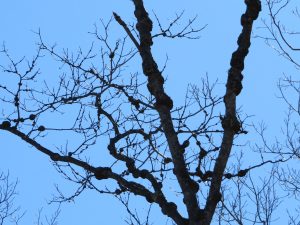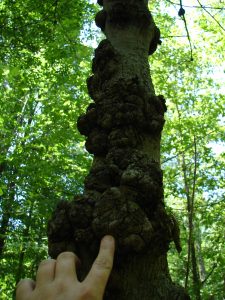
Northern red oak with many phomopsis galls on the branches and on the main stem.
Phomopsis galls are large, woody galls caused by a fungus and can be unsightly on the branches of trees (people often notice them in the winter when leaves are off). They occur in hickories, maples, oaks and a few other species. In northeastern Wisconsin, I find them most commonly on hickory, but in some areas northern red oaks can be heavily galled. Counties where I’ve seen these large galls on northern red oak include Oconto, Oneida, Shawano and Vilas.

It’s more common to see phomopsis galls on bitternut hickory.
Infections can be localized to a single tree with neighboring trees completely unaffected, or a small group of trees may be infected. Larger infection centers can be found as well. There are some unknowns related to life cycle, how the disease is spread, and more. Phomopsis galls range in size from very small, to larger than your head. Small phomopsis galls may look similar to gouty oak gall, which is a gall that forms on a branch in response to attack by a small wasp.
There is no known treatment for phomopsis galls. You can prune them out and dispose of them, harvest the tree, or simply live with them. If left on the tree they may eventually cause dieback or girdling of the branch that they are on, but the tree may live for many decades with galls on the main stem or branches. The presence of galls does not guarantee the rapid death of a tree, but I’m not aware of any studies that have explored this issue in depth.
Written by: Linda Williams, forest health specialist, Green Bay, (Linda.Williams@wisconsin.gov), 920-662-5172.
